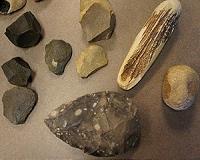 |
Oxford, UK (SPX) Nov 08, 2010 Evolutionary divergence of humans from chimpanzees likely occurred some 8 million years ago rather than the 5 million year estimate widely accepted by scientists, a new statistical model suggests. The revised estimate of when the human species parted ways from its closest primate relatives should enable scientists to better interpret the history of human evolution, said Robert D. Martin, curator of biological anthropology at the Field Museum, and a co-author of the new study appearing in the journal Systematic Biology. Working with mathematicians, anthropologists and molecular biologists, Martin has long sought to integrate evolutionary information derived from genetic material in various species with the fossil record to get a more complete picture. Comparing DNA among related animals can provide a clear picture of how their shared genes evolved over time, giving rise to new and separate species, Martin said. But such molecular information doesn't yield a timetable showing when the genetic divergence occurred. Fossil evidence is the only direct source of information about long-extinct species and their evolution, Martin and his colleagues said, but large gaps in the fossil record can make such information difficult to interpret. For a generation, paleontologists have estimated human origins at 5 million to 6 million years ago. But that estimate rests on a thin fossil record. By looking at all of today's primate species, all of the known fossil primates and using DNA evidence, computer models suggest a longer evolutionary timetable. The new analysis described in the Systematic Biology paper takes into account gaps in the fossil record and fills in those gaps statistically. Such modeling techniques, which are widely used in science and commerce, take into account more overall information than earlier processes used to estimate evolutionary history using just a few individual fossil dates, Martin said. It can give scientists a broader perspective for interpreting data. One example is a skull fossil discovered in Chad (central Africa) earlier in this decade. The fossil, named Sahelanthropus tchadensis and nicknamed Toumai (which means "hope of life" in the local Goran language), raised great interest because it has many human characteristics. But consensus on how to classify the discovery has been elusive particularly because the fossil is about 7 million years old, well beyond the accepted time frame for human evolution. Under the new estimate, Toumai would fall within the period after the human lineage split from chimpanzees, Martin said. The new approach to dating evolutionary history builds on earlier work by Martin and colleagues. In 2002, they published a paper in Nature that argues the last common ancestor of today's primates lived some 85 million years ago. This implies that for 20 million years before dinosaurs became extinct, early versions of primates also lived and evolved. It challenged the accepted theory that primates and other mammals didn't really thrive on the planet until dinosaurs were gone. After that paper was published, Martin said he expected someone would apply the new statistical techniques to the question of human evolution, but when no one did, "We decided to do it ourselves." The article in full can be found here.
Share This Article With Planet Earth
Related Links Field Museum All About Human Beings and How We Got To Be Here
 Brain Trumps Hand In Stone Age Tool Study
Brain Trumps Hand In Stone Age Tool StudyLondon, UK (SPX) Nov 08, 2010 Was it the evolution of the hand, or of the brain, that enabled prehistoric toolmakers to make the leap from simple flakes of rock to a sophisticated hand axe? A new study finds that the ability to plan complex tasks was key. The research, published in the Public Library of Science journal PLoS ONE, is the first to use a cyber data glove to precisely measure the hand movements of stone too ... read more |
|
| The content herein, unless otherwise known to be public domain, are Copyright 1995-2010 - SpaceDaily. AFP and UPI Wire Stories are copyright Agence France-Presse and United Press International. ESA Portal Reports are copyright European Space Agency. All NASA sourced material is public domain. Additional copyrights may apply in whole or part to other bona fide parties. Advertising does not imply endorsement,agreement or approval of any opinions, statements or information provided by SpaceDaily on any Web page published or hosted by SpaceDaily. Privacy Statement |